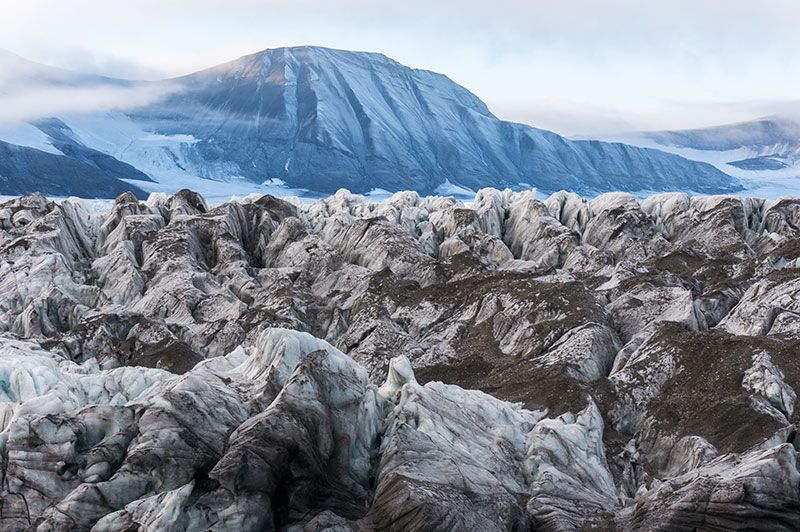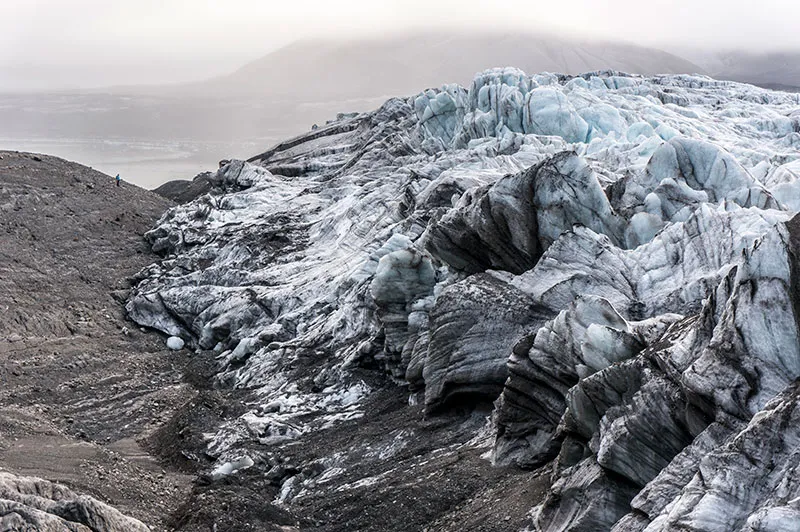What the Surging Glaciers of Svalbard Tell Us About the Future of Rising Seas
Scientists look to the Norwegian archipelago’s fast-moving glaciers to better understand how other accelerating glaciers will behave
/https://tf-cmsv2-smithsonianmag-media.s3.amazonaws.com/filer/6c/5d/6c5d38f2-c12b-4946-ae9a-47ff1646e0a1/surging_glacier.jpg)
Heidi Sevestre remembers the dramatic, otherworldly experience of approaching a surging glacier for the first time.
In 2013, as her research team’s boat drew close to the Norwegian archipelago of Svalbard, they watched pieces of ice calving into the sea. Booming sounds, like shots from colossal guns, echoed across the water. As they got nearer, they saw deep crevasses crisscrossing the glacier’s surface and a landscape bulldozed by the movement of millions of tons of ice.
"It felt like we were in the presence of this huge monster of ice," the glaciologist says. "I was just stunned. Surging glaciers are like nothing else."
Over much of the Earth, most glaciers move, well, glacially. In Svalbard, some of them surge. They’re the Speed Racers of glaciers.
Surging glaciers are broadly defined as flowing at least 10 times and as much as 100 times faster than normal glaciers. They are found in the ring of the Arctic Circle, including Alaska, Norway and Canada's Yukon Territory, and western central Asia, including western Tibet and the Karakoram and Pamir mountain ranges. And they are dangerous. In 2016, what some—but not all—researchers consider a surging glacier in Tibet unleased an avalanche of 90 million cubic yards of ice and rock, killing nine herders, more than 100 yaks and 350 sheep. In 2002, the Kolka glacier in a valley along the Russia-Georgia border collapsed, creating an avalanche that killed more than 100 people. In Svalbard, surging glaciers pocked with crevasses force the closing of snowmobile routes and make passage impossible. Researchers studying them train in crevasse rescue.
Svalbard is the perfect place to explore the still-infant research into surging glaciers. The island group has the densest population of them in the world. While only 1 percent of glaciers worldwide are surging, about a quarter of the glaciers on the archipelago meet the classification.

Now, scientists are looking to surging glaciers as a glimpse into the future, as glaciers increasingly melt across the globe. Understanding the dynamics of what causes surges may help predict how large glaciers on Greenland and in the Antarctic will behave and help scientists more accurately predict sea level rise. Why? The processes are similar.
"For many years, people have more or less neglected the surging glaciers especially in areas like Svalbard because these are small glaciated areas," says Jon Ove Hagen, a University of Oslo researcher who has studied glaciers for more than 30 years. "What we have seen recently in Antarctica and especially Greenland is the accelerating of the glaciers from the ice sheet. Our understanding of that is still unclear. That's where we can learn a lot from the surging glaciers in Svalbard."
Glacial melt accounts for about a third of the ongoing sea level rise, but Sevestre notes that the effects of surging glaciers are not considered in current climate change models because the timing and the strength of their surges cannot be predicted.
The glacier Sevestre saw that first day, named Wahlenbergbreen, is one of many on Svalbard that sits quiet, and then suddenly advances far more quickly than others across the globe, moving as much as 50 feet a day compared to the normal three feet. They are misers that go on a big spending spree every few decades or even every few centuries, storing their mass and energy then unleashing them in a spectacular and destructive assault worthy of a disaster movie.
In a study released earlier this year, Sevestre, a consultant for the International Cryosphere Climate Initiative, and six other researchers looked at what initiated surges at Wahlenbergbreen and Aavatsmarkbreen, Svalbard glaciers emptying into the sea. Typical surges are triggered either at the top of the glacier or in the middle, and the velocity moves down the glacier. The surges last a decade or more. Now, they are observing a new type of surge on calving glaciers where the surge is triggered at the front, where chunks of ice fall into the sea. These surges are shorter, usually a couple of years.
Water and warmth, they determined, were key. "These surges are very different in character and magnitude from what we've been used to seeing in Svalbard, a real shift in behavior," Sevestre says.
Surges are complex, the likely result of several factors. Their study indicated the warmer the climate, the more calving glaciers will melt at their front. That increases the slope compared to the rest of the glacier. The steeper the slope, the faster it moves, stretching the glacier and creating more crevasses. Enter precipitation. Glaciers surge when water accumulates at the base of the ice.
Water can accumulate at the bed of glaciers from several causes. A large thickening from snow accumulation can lower the pressure melting point of the ice creating meltwater. Warmer ice can move more easily and that friction in turn creates more warming. Water can also come from surface melting and precipitation and enter rapidly through crevasses. That water acts as a lubricant, triggering a surge that dumps a massive amount of ice, through calving, and water, through melting, into the seas.
Adrian Luckman, one of the study's co-authors, a glaciologist and geography chair at Swansea University, says the study signals more research is needed to understand the effect of climate change.
But Sevestre sees "a real shift" and a potential link to the warmer and wetter climate. "Our study lets us think that climate change will affect the mechanism that triggers surges, as well as the duration and intensity of the surges," she explains. "For now, it appears that the surges of tidewater glaciers could be the canary in the coal mine."
Their report follows the unexpected surge of a Svalbard glacier beginning in 2016. Surges run in cycles of roughly several decades. But one Svalbard glacier, Tunabreen, recently started surging well ahead of schedule. Tunabreen surged in 1870, 1930, 1971, and from 2002 to 2006. The next surge was not expected until at least 2030. But it began exceeding the glacial speed limit again in 2016. Sevestre says that until Tunabreen began speeding up in 2016, researchers believed climate change had a limited impact on triggering surges.
More rainfall and less snow in the summer and fall in Svalbard in recent years appears to have triggered Tunabreen to surge decades ahead of schedule. "Tunabreen definitely was a surprise. We weren't expecting that one to surge for another few decades," says Chris Borstad, a professor and researcher at The University Centre in Svalbard. "It began surging when we had record warm temperatures and rainfall in the fall of 2016. We may expect that in a warming climate we may see more surges triggered."

Surging glaciers exist across the globe in climate niches that fit them like a well-tailored suit. In Svalbard, the climate is not warm enough to permit glaciers to expel their meltwater. But it is also not cold enough or dry enough to prevent too much snow from accumulating, meaning heat cannot escape easily.
"The current climate triggers surges in very well defined clusters found in Alaska, Iceland, parts of Greenland, Svalbard, small islands north of Siberia, Kamchatka, Karakoram," Sevestre says. "Past climates could have triggered surges in other places such as the European Alps during the 16th and 17th century. Shifts in climate could encourage glaciers to wake up in non-surge regions and vice versa."
What about the effect on sea level rise? The question lingers. Sevestre notes that a recent study of the giant Austfonna glacier, which surged from 2012 to 2016, doubled the ice mass loss of Svalbard. Andreas Kaab, a researcher at the University of Oslo, says understanding surging glaciers is vital to modeling sea level rise.
"The total amount of glacier ice potentially contributing to the sea level is not changing by surges, but the timing and speed of this contribution (is changing)," he says, also citing the Austfonna surge. "For instance, a massive increase in surges would lead to a much faster sea level rise than anticipated, though to the same final level as anticipated."
Researchers earlier this year used a water drill to bore down 1,000 feet into a Svalbard glacier, Kongsvegen, a glacier that last surged in 1948 and is awakening. They installed sensors to track temperature and water pressure changes. Measurements from the sensors are wired to the surface, where they are recorded by a data logger powered by a solar panel and batteries.
“We do hope that the glacier surges soon so that we can learn more about surge dynamics,” Borstad says. “Even if it doesn't surge we'll have a nice dataset showing seasonal dynamics within the glacier.”
Historical reports about surging glaciers go back centuries. The first surge widely covered in the media was the Black Rapids Glacier in Alaska in 1937. It advanced more than three miles in a year, earning the names “galloping glacier” and “runaway glacier” in press reports. But the difficulty studying them means there are more questions than answers.
"I think we truly are right at the beginning of understanding what is taking place when glaciers are surging," Sevestre says. “We know more about Mars or the surface of the moon than what is underneath that ice."
/https://tf-cmsv2-smithsonianmag-media.s3.amazonaws.com/accounts/headshot/jim-morrison-240.jpg)
/https://tf-cmsv2-smithsonianmag-media.s3.amazonaws.com/accounts/headshot/jim-morrison-240.jpg)